Inguinal hernia repair
Inguinal hernia repair is surgery to repair a hernia in your groin. A hernia is tissue that bulges out of a weak spot in the abdominal wall. Your intestine may bulge out through this weakened area.
Hernia
A hernia is a sac formed by the lining of the abdominal cavity (peritoneum). The sac comes through a hole or weak area in the strong layer of the be...

Inguinal hernia repair - Animation
Hernias are one of the most common reasons for children to need surgery. Thankfully, the risks today are very low, and the results are excellent. Let's talk about inguinal hernia repair. Before a baby is born, the testicles and ovaries begin life in the back of the belly. As the baby develops, the testicles or ovaries descend into their place in the body through a tube called the inguinal canal. If the canal doesn't close afterward some of the intestines can slip through and create a bulge, or hernia, in the baby's groin. Premature babies tend to develop hernias more than full-term babies. Boys are more likely to have hernias than girls. Hernias can also run in families, and they're often associated with other problems, like undescended testicles. How do you know if your child has an inguinal hernia? Parents usually notice a lump or bulge in their child's groin, scrotum, or labia during bath time or while changing a diaper. It may appear when the child cries or strains, and disappear when they are relaxed or asleep. Sometimes some of the intestine will get trapped in the hernia, causing pain. The child gets fussy and may cry inconsolably. If blood supply to the intestine is cut off, the bulge may be red and tender, and the child may have a fever and a racing heart rate. Inguinal hernias do not go away without treatment. The good news is a simple, safe operation can close the inguinal canal. Your child will usually receive general anesthesia, and be asleep and without pain. The surgeon will make a small cut near the hernia, push the intestine back into your child's belly, and close the inguinal canal. Your child should go home the same day. When you get your child home, don't be concerned if you notice swelling or some bruising in the area of the surgery. That's to be expected - it's normal. And you can kind of go with your child's desired level of activity for a bit. In fact, encouraging them to move some will help speed recovery, but you want to avoid really rough play or extreme activity for the first week or so until the incision begins to really repair.
Description
During surgery to repair the hernia, the bulging tissue is pushed back into your abdomen. Your abdominal wall is strengthened and supported with sutures (stitches), and often mesh. This repair can be done with open or laparoscopic surgery. You and your surgeon can discuss which type of surgery is right for you.
Your surgeon will decide which kind of anesthesia you will receive:
- General anesthesia is medicine that keeps you asleep and pain-free.
General anesthesia
General anesthesia is treatment with certain medicines that puts you into a deep sleep-like state so you do not feel pain during surgery. After you ...
Read Article Now Book Mark Article - Regional anesthesia, which numbs you from the waist to your feet.
Regional anesthesia
Spinal and epidural anesthesia are procedures that deliver medicines that numb parts of your body to block pain. They are given through shots in or ...
 ImageRead Article Now Book Mark Article
ImageRead Article Now Book Mark Article - Local anesthesia and medicine to relax you.
Local anesthesia and medicine to relax ...
Conscious sedation uses a combination of medicines to help you relax (a sedative) and to reduce pain (an analgesic) during a medical or dental proced...
Read Article Now Book Mark Article
In open surgery:
- Your surgeon makes a cut near the hernia.
- The hernia is located and separated from the tissues around it. The hernia sac is removed or the hernia is gently pushed back into your abdomen.
- Your surgeon then closes your weakened abdominal muscles with stitches.
- Often a piece of mesh is also sewn into place to strengthen your abdominal wall. This repairs the weakness in the wall of your abdomen.
- At the end of the repair, the cut is stitched, stapled or glued.
In laparoscopic surgery:
- The surgeon makes three to five small cuts in your lower belly.
- A medical device called a laparoscope is inserted through one of the cuts. The scope is a thin, lighted tube with a camera on the end. It lets your surgeon see inside your belly.
- A harmless gas is pumped into your belly to expand the space. This gives your surgeon more room to see and work.
- Other tools are inserted through the other cuts. Your surgeon uses these tools to repair the hernia.
- The same repair will be done as the repair in open surgery, including mesh placement.
- At the end of the repair, the scope and other tools are removed. The cuts are stitched.
Why the Procedure Is Performed
Your health care provider may suggest hernia surgery if you have pain or your hernia bothers you during your everyday activities. If the hernia is small and not causing any symptoms, you may not need surgery. However, these hernias most often do not go away on their own, tend to get larger, and a good number end up needing surgery.
Hernia - Animation
You're lifting a heavy box, when suddenly, you feel a strain in your stomach or groin. If you also feel a bulge there, you might have a hernia. The bump that you feel is a part of what's in your abdomen bulging out through a weak spot in the muscle or tissue that surrounds it. A hernia is kind of like pushing your finger against the side of a balloon. What type of hernia you have depends on where the bulge is located. A femoral hernia is a bulge in the upper part of your thigh. A hiatal hernia is located in the top part of your stomach. An umbilical hernia bulges around your belly button. Inguinal hernias are in the groin area. And incisional hernias usually form around a scar from a past surgery in your abdomen. You can get a hernia if you lift something that's too heavy, or strain too hard while coughing, urinating, or having a bowel movement. Sometimes babies are born with a hernia. That happens when the lining that is supposed to hold the abdominal organs doesn't totally close before birth. Some hernias don't cause any symptoms. You might live with a hernia for a while without even noticing that you have it. Or, you may see an actual bulge in your leg, stomach, or groin. Hernias can sometimes be painful, especially when you strain or lift something heavy. Your doctor should be able to locate the hernia during an exam. If your hernia is small and doesn't bother you, you may not need to do anything but keep in touch with your doctor to make sure it isn't growing. If the hernia is big or painful, your doctor may recommend surgery to plug the opening. The one big risk to having a hernia is that with some types the tissue can get caught inside the hole. This is called strangulation. It can be very dangerous, because blood is cut off to the part of the organ that's trapped. Eventually that tissue will die. If you have a strangulated hernia, you'll need to have emergency surgery. Surgery is the only way to reverse a hernia, although in young children umbilical hernias will often go away on their own. If you have a small hernia and decide not to have surgery, be on the lookout for any changes. Call the doctor right away if you have pain, nausea, vomiting, or a fever, or if your hernia turns red, purple, or another color. These could be signs of strangulation. To avoid a hernia in the first place, be careful when lifting heavy objects. Drink plenty of fluids and add fiber to your diet so you won't have to push too hard on the toilet. And see a urologist if you're straining while urinating.
Sometimes the intestine can be trapped inside the hernia. This is called an incarcerated or strangulated hernia. It can cut off blood supply to the intestines. This can be life threatening. If this happens, you would need emergency surgery.
Risks
Risks for anesthesia and surgery in general are:
- Reactions to medicines
- Breathing problems
Breathing problems
Breathing difficulty may involve:Difficult breathing Uncomfortable breathingFeeling like you are not getting enough air
 ImageRead Article Now Book Mark Article
ImageRead Article Now Book Mark Article - Bleeding, blood clots, or infection
Bleeding
Bleeding is the loss of blood. Bleeding may be:Inside the body (internal)Outside the body (external)Bleeding may occur:Inside the body when blood le...
 ImageRead Article Now Book Mark Article
ImageRead Article Now Book Mark ArticleBlood clots
Blood clots are clumps that occur when blood hardens from a liquid to a solid. A blood clot that forms inside one of your veins or arteries is calle...
 ImageRead Article Now Book Mark Article
ImageRead Article Now Book Mark Article - Nausea and vomiting
Risks for this surgery are:
- Damage to other blood vessels or organs
- Damage to the nerves
- Damage to the testicles if a blood vessel connected to them is harmed
- Long-term pain in the cut area
- Return of the hernia
Before the Procedure
Tell your surgeon or nurse if:
- You are or could be pregnant.
- You are taking any medicines, including medicines, drugs, supplements, or herbs you bought without a prescription.
Planning for your surgery:
- If you have diabetes, heart disease, or other medical conditions, your surgeon may ask you to see the provider who treats you for these conditions.
Diabetes
Diabetes is a long-term (chronic) disease in which the body cannot regulate the amount of sugar in the blood.
 ImageRead Article Now Book Mark Article
ImageRead Article Now Book Mark ArticleHeart disease
Coronary heart disease is a narrowing of the blood vessels that supply blood and oxygen to the heart. Coronary heart disease (CHD) is also called co...
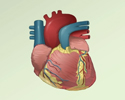 ImageRead Article Now Book Mark Article
ImageRead Article Now Book Mark Article - If you smoke, it's important to cut back or quit. Smoking can slow healing and increase the risk for blood clots. Ask your provider for help quitting smoking.
Smoking can slow healing and increase t...
Quitting smoking and other nicotine products, including e-cigarettes, before surgery can improve your recovery and outcome after surgery. Most people...
Read Article Now Book Mark ArticleQuitting smoking
There are many ways to quit smoking. There are also resources to help you. Family members, friends, and co-workers may be supportive. But to be su...
 ImageRead Article Now Book Mark Article
ImageRead Article Now Book Mark Article - If needed, prepare your home to make it easier to recover after surgery.
Prepare your home
Getting your home ready after you have been in the hospital often requires much preparation. Set up your home to make your life easier and safer when...
Read Article Now Book Mark Article - Ask your surgeon if you need to arrange to have someone drive you home after your surgery.
During the week before your surgery:
- You may be asked to temporarily stop taking medicines that keep your blood from clotting. These medicines are called blood thinners. This includes over-the-counter medicines and supplements such as aspirin, ibuprofen (Advil, Motrin), naproxen (Aleve, Naprosyn), and vitamin E. Many prescription medicines are also blood thinners.
- Ask your surgeon which medicines you should still take on the day of surgery.
- Let your surgeon know about any illness you may have before your surgery. This includes COVID-19, a cold, flu, fever, herpes breakout, or other illness. If you do get sick, your surgery may need to be postponed.
COVID-19
Coronavirus disease 2019 (COVID-19) is a respiratory illness that causes fever, coughing, and shortness of breath, but many other symptoms can occur....
 ImageRead Article Now Book Mark Article
ImageRead Article Now Book Mark ArticleCold
The common cold most often causes a runny nose, nasal congestion, and sneezing. You may also have a sore throat, cough, headache, or other symptoms....
 ImageRead Article Now Book Mark Article
ImageRead Article Now Book Mark ArticleFlu
The flu (influenza) is a viral respiratory illness that causes fever, chills, runny nose, body aches, and cough. It spreads easily from person to pe...
 ImageRead Article Now Book Mark Article
ImageRead Article Now Book Mark Article
On the day of surgery:
- Follow instructions about when to stop eating and drinking.
- Take the medicines your surgeon told you to take with a small sip of water.
- Arrive at the hospital on time.
After the Procedure
Most people are able to get out of bed an hour or so after this surgery. Most can go home the same day, but some may need to stay in the hospital overnight.
Some men may have problems passing urine after hernia surgery. If you have problems urinating, you may need a catheter. This is a thin flexible tube that is inserted into your bladder for a short time to drain urine.
Following instructions about how active you can be while recovering. This may include:
- Returning to light activities soon after going home, but avoiding strenuous activities and heavy lifting for a few weeks.
- Avoiding activities that can increase pressure in the groin and belly. Move slowly from a lying to a seated position.
- Drinking plenty of fluids and eating lots of fiber to prevent constipation.
Follow any other self-care instructions to help speed your recovery.
Self-care instructions
You or your child had surgery to repair an inguinal hernia caused by a weakness in the abdominal wall in your groin area. Now that you or your child ...

Outlook (Prognosis)
The outcome of this surgery is usually very good. In some people, the hernia returns.
Reviewed By
Jonas DeMuro, MD, Diplomate of the American Board of Surgery with added Qualifications in Surgical Critical Care, Assistant Professor of Surgery, Renaissance School of Medicine, Stony Brook, NY. Review provided by VeriMed Healthcare Network. Also reviewed by David C. Dugdale, MD, Medical Director, Brenda Conaway, Editorial Director, and the A.D.A.M. Editorial team.
Poulose BK, Carbonell AM, Rosen MJ. Hernias. In: Townsend CM Jr, Beauchamp RD, Evers BM, Mattox KL, eds. Sabiston Textbook of Surgery. 21st ed. St Louis, MO: Elsevier; 2022:chap 45.
Wiseman JE, Adrales GL. Management of inguinal hernia. In: Cameron J, ed. Current Surgical Therapy. 14th ed. Philadelphia, PA: Elsevier; 2023:663-667.



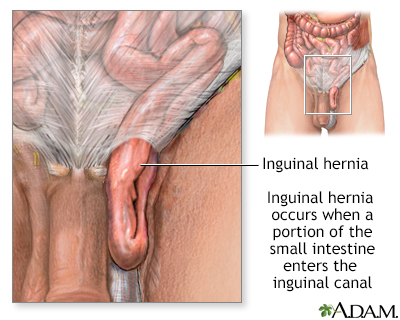
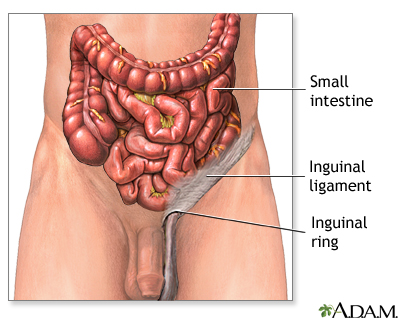

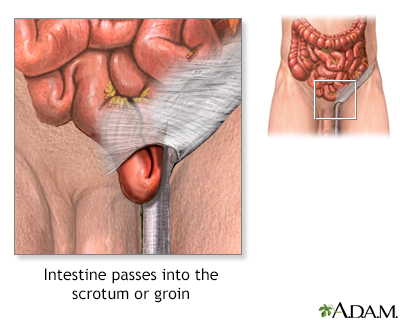
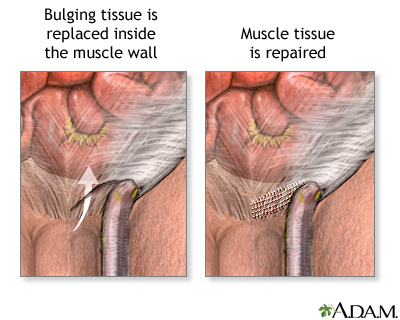

 All rights reserved.
All rights reserved.